
Gladesville Bridge is a heritage-listed concrete arch road bridge that carries Victoria Road over the Parramatta River, linking the Sydney suburbs of Huntleys Point and Drummoyne, in the local government areas of Canada Bay and Hunter's Hill, in New South Wales, Australia. Despite its name, the bridge is not in Gladesville.

The Sydney Football Stadium, commercially known as Allianz Stadium and previously Aussie Stadium, was a football stadium in the Moore Park suburb of Sydney, New South Wales, Australia. Built in 1988 next to the Sydney Cricket Ground, the stadium was Sydney's premier rectangular field venue for rugby league, rugby union and football.
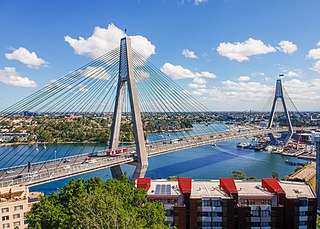
The Anzac Bridge is an eight-lane cable-stayed bridge that carries the Western Distributor (A4) across Johnstons Bay between Pyrmont and Glebe Island, on the western fringe of the Sydney central business district, New South Wales, Australia. The bridge forms part of the road network leading from the central business district, the Sydney Harbour Bridge, and Cross City Tunnel to the Inner West and Northern Suburbs.

Moore Park is a suburb in the Eastern Suburbs of Sydney located 3 kilometres (1.9 mi) from the CBD, in the state of New South Wales, Australia. It is part of local government area of the City of Sydney.

The Pyrmont Bridge, a heritage-listed swing bridge across Cockle Bay, is located in Darling Harbour, part of Port Jackson, west of the central business district in the City of Sydney local government area of New South Wales, Australia. Opened in 1902, the bridge initially carried motor vehicle traffic via the Pyrmont Bridge Road between the central business district and Pyrmont. Since 1981 the bridge has carried pedestrian and bicycle traffic only, as motor vehicles were diverted to adjacent freeway overpasses. The bridge was added to the New South Wales State Heritage Register on 28 June 2002, the centenary of its opening.

The Glebe Island Bridge is a heritage-listed disused swing Allan truss road bridge that carried Victoria Road across Rozelle Bay, located in the inner city Sydney suburb of Pyrmont in the City of Sydney local government area of New South Wales, Australia. The bridge, that connected Rozelle to Pyrmont by road, is one of the last remaining swing bridges of its type in Australia and in the world. It was designed by Percy Allan and built from 1899 to 1903 by Bridges Branch of NSW Public Works Department. It is also known as RMS Bridge No. 61. It was added to the New South Wales State Heritage Register on 29 November 2013 and was listed on the Register of the National Estate on 19 April 1989.
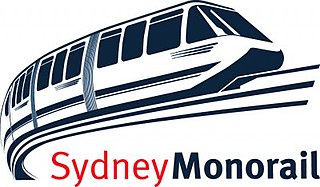
The Sydney Monorail was a single-loop monorail in Sydney, Australia, that connected Darling Harbour, Chinatown and the Sydney central business and shopping districts. It opened in July 1988 and closed in June 2013.

Tharwa Bridge is a four span Allan truss bridge that provides a high-level crossing point across the Murrumbidgee River, allowing traffic between Canberra and Tharwa village. It is the oldest surviving bridge in the Australian Capital Territory.

The Captain Cook Bridge is a road bridge that carries Taren Point and Rocky Point Roads across the Georges River in southern Sydney, in the state of New South Wales, Australia. The precast prestressed concrete girder bridge crosses near the river mouth as it empties into Botany Bay; and links the St George and Sutherland areas of Sydney. The bridge comprises a dual carriageway with three lanes in each direction of highway grade-separated conditions; and pedestrian and bicycle traffic, via two grade-separated paths. on the eastern and western sides of the bridge.

Anzac Parade is a major road in the eastern suburbs of Sydney, Australia which travels south-east from the CBD, named in memory of members of the First Australian Imperial Force who marched down the street from their barracks to Sydney Harbour, where they were transported to Europe during World War I.

Albert "Tibby" Cotter was an Australian cricketer who played in 21 Test matches between 1904 and 1912. He served in World War I with the First Australian Imperial Force and was killed in action in the mounted charge of the 4th Light Horse Brigade at Beersheba in Ottoman Palestine.

Centennial Parklands is the name given to a group of three urban parklands located in the eastern suburbs of Sydney, New South Wales, Australia. Comprising approximately 360 hectares, the lands encompass Centennial Park, Moore Park and Queens Park. The Parklands are listed on the New South Wales Heritage Register, with various components of national, state or local heritage significance. The parks are contained within the local government areas of City of Randwick, Waverley Municipal Council, and City of Sydney.

Sydney Metro Northwest was a rapid transit project that constructed the first section of the Metro North West Line through the north-western suburbs of Sydney, New South Wales, Australia. The project included the conversion of the existing Epping to Chatswood rail link to metro standards and connects the suburbs of Rouse Hill and Chatswood via Castle Hill and Epping. The project was managed by Transport for NSW. The completed Metro North West Line opened on the 26 May 2019.
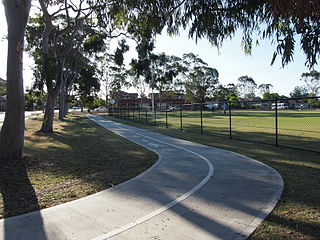
Bike paths in Sydney, New South Wales, Australia, vary widely, with the majority either shared cycle and pedestrian paths or on road paths, and a small number of separated cycleways. In 2009 the Sydney Morning Herald reported that "Sydney's cycleways are not so much an organised network as a fragmented collection of winding paths and half-finished ideas. Most were built or designed when cycling was viewed as a pleasant pastime rather than a practical form of travel and are now poorly suited to commuting."
WestConnex is a 33-kilometre (21 mi) predominantly underground motorway scheme in Sydney, New South Wales, Australia. A joint project of the New South Wales and Federal governments, the motorway scheme created around 26 kilometres (16 mi) of new tunnels between Homebush and Kingsgrove, passing underneath Inner West suburbs including Haberfield and St Peters. The first of the tunnels, the M4 East, opened to traffic in July 2019. The second of the tunnels, the M8 Motorway, opened to traffic a year later in July 2020. The third of the tunnels which extend the M4 and M8 opened to traffic in January 2023. The final component of the scheme, the Rozelle Interchange, opened to traffic in November 2023.
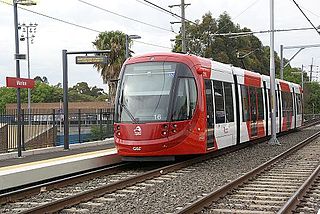
The Inner West Light Rail is a 12.8-kilometre (8.0 mi) light rail line in Sydney, New South Wales, Australia, running from Central railway station through the Inner West to Dulwich Hill and serving 23 stops. It is the original line of the Sydney light rail network, and was originally known as Sydney Light Rail. Light rail services on the line are now branded as the L1 Dulwich Hill Line.
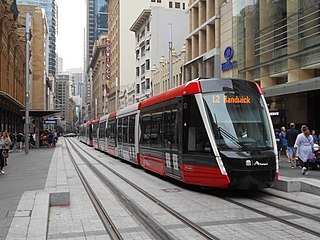
The CBD and South East Light Rail is a pair of light rail lines running between Sydney's central business district (CBD) and the south-eastern suburbs of Sydney, New South Wales, Australia. It consists of the L2 Randwick Line which runs between Circular Quay and Randwick, as well as the L3 Kingsford Line which runs between Circular Quay and Kingsford. Construction commenced in October 2015, with the L2 Randwick Line commencing services on the 14 December 2019 and the L3 Kingsford Line on the 3 April 2020. It is part of Sydney's light rail network.
The Gore Hill and Epping Road cycleways is a 8.4-kilometre-long (5.2 mi) conjoined shared use path for cyclists and pedestrians, and an on road cycleway located in the lower north shore of Sydney, New South Wales, Australia. The eastern terminus of the cycleway is in Naremburn, while the western terminus is in North Ryde.
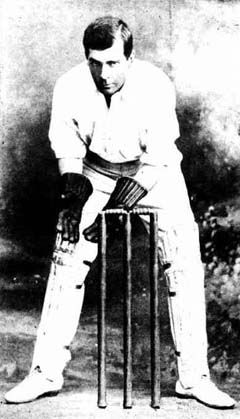
Charles Richard Gorry was an Australian cricketer. He played first-class cricket as a wicket-keeper for New South Wales from 1907/08 to 1910/11.
The M6 Motorway is an under-construction motorway in Sydney, New South Wales consisting of twin, 4-kilometre long tunnels linking the M8 Motorway at Arncliffe to President Avenue at Kogarah. This section started major construction in November 2021 and is expected to open in late 2025. The possibility of future extensions to the south will be accommodated by providing stub tunnels in the project.


















